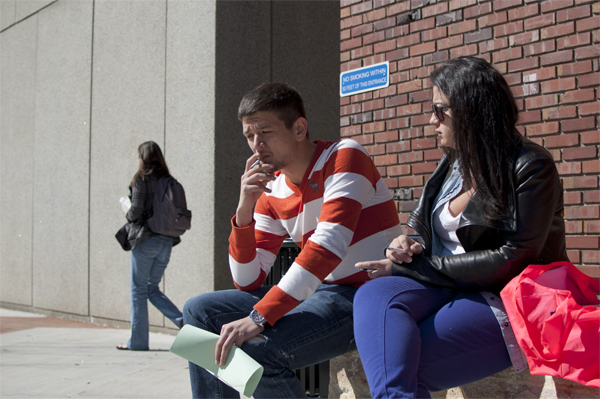

Student senators are looking to stomp out smoking near SUNY New Paltz’s buildings.
Sen. Jonathan Espinosa, Wendy Cohen and Manuel Tejada have spearheaded a project to look into different ways to curb plumes of smoke on campus through a variety of different options, including stronger enforcement and education of the 50 feet rule surrounding all buildings at the college.
“I think the fundamental issue is respect,” Espinosa said. “I feel it’s disrespectful to blow cigarette smoke in my airspace as I come out or enter class.”
At the senate meeting on March 13, Student Association (SA) President Terrell Coakley said if a senator wanted to lead the project and find a viable solution, the smoking zones policy could continue to be worked on.
“Look up other campuses and see what they do,” Coakley said. “Right now it’s been an ongoing argument…I don’t know if it’s a project we could realistically accomplish in a semester.”
Espinosa said while he couldn’t be sure, the project could take a year to get up-and-running due to the potential formation of a committee of both smokers and non-smokers to review the options being considered by the senate.
Multiple complaints about the amount of cigarette smoke on certain areas on campus — most notably the concourse that connects the Lecture Center, Humanities Building, Coykendall Science Building and Jacobson Faculty Tower — have reached senate, and it has been a topic of debate at senate meetings, Espinosa said.
Espinosa said, legally speaking, no smoking is permitted on any point on the concourse, as no two buildings are more than 50 feet apart.
“I think cigarette smokers can just find a place away from the buildings,” Espinosa said. “The whole thing isn’t that it’s annoying, it’s about fire safety. If there is a law on the basis of fire safety, we should respect that.”
Some options being considered by the senators include moving the cigarette disposals farther away from buildings and changing signs on buildings to uniformly say “no smoking in this area” rather than “no smoking within 50 feet,” Espinosa said.
Other options Espinosa outlined included putting zone lines around each building on campus to clearly depict how far smokers would need to walk to be permitted to spark up.
“People then wouldn’t have an excuse by saying ‘I don’t know what that means,’” Espinosa said. “I don’t even know how far 50 feet is, so I understand.”
Finally, Espinosa said the college administration is considering installing a gazebo on campus to accommodate smokers.
Students on campus have differing opinions on the enforcement of smoking on campus.
Jordan Reisman, a fourth-year anthropology major, said while he is not a smoker he believes if people are not smoking inside, there’s no problem with it.
“I believe that people should be allowed to smoke as they please,” Reisman said. “That area is almost designated as a smoker’s hangout, and everyone already knows that. If being in that area around smoke really bothers people, they should just move.”
Steve Mihalik, a fourth-year English major, said he is in favor of the senate’s potential plans.
“Cigarette smoke is intrusive and unhealthy,” Mihalik said. “It wouldn’t be right to banish people, but a designated area where it’s permitted would be a good thing.”
